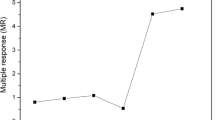Abstract
A non-oxidative alkaline sample digestion procedure using tetramethylammonium hydroxide and a high pressure, microwave assisted autoclave digestion system was developed. The silicon concentrations of the digested samples were measured by inductively coupled axial plasma optical emission spectrometry (ICP-OES). Details of the digestion conditions as well as the optimised instrumental parameters for ICP-OES are described. The method was developed and tested using silicon-spiked ascorbic acid and applied to samples of animal tissue and organs. The total silicon content of two different reference materials, NIST 1577b Bovine liver and BCR 184 Bovine Muscle having neither certified nor informational values for Si was determined. The results obtained are compared with the results of independent methods such as wavelength dispersive x-ray fluorescence spectrometry (WDXRF) and solid sampling electrothermal atomic absorption spectrometry (ETAAS). The method described achieves a limit of detection of 2 mg kg–1 using 100 mg of solid biological or organic material and covers a concentration range of up to 500 mg kg–1.
Similar content being viewed by others
Author information
Authors and Affiliations
Additional information
Received: 27 October 2000 / Revised: 31 January 2001 / Accepted: 2 February 2001
Rights and permissions
About this article
Cite this article
Hauptkorn, S., Pavel, J. & Seltner, H. Determination of silicon in biological samples by ICP-OES after non-oxidative decomposition under alkaline conditions. Fresenius J Anal Chem 370, 246–250 (2001). https://doi.org/10.1007/s002160100759
Issue Date:
DOI: https://doi.org/10.1007/s002160100759




